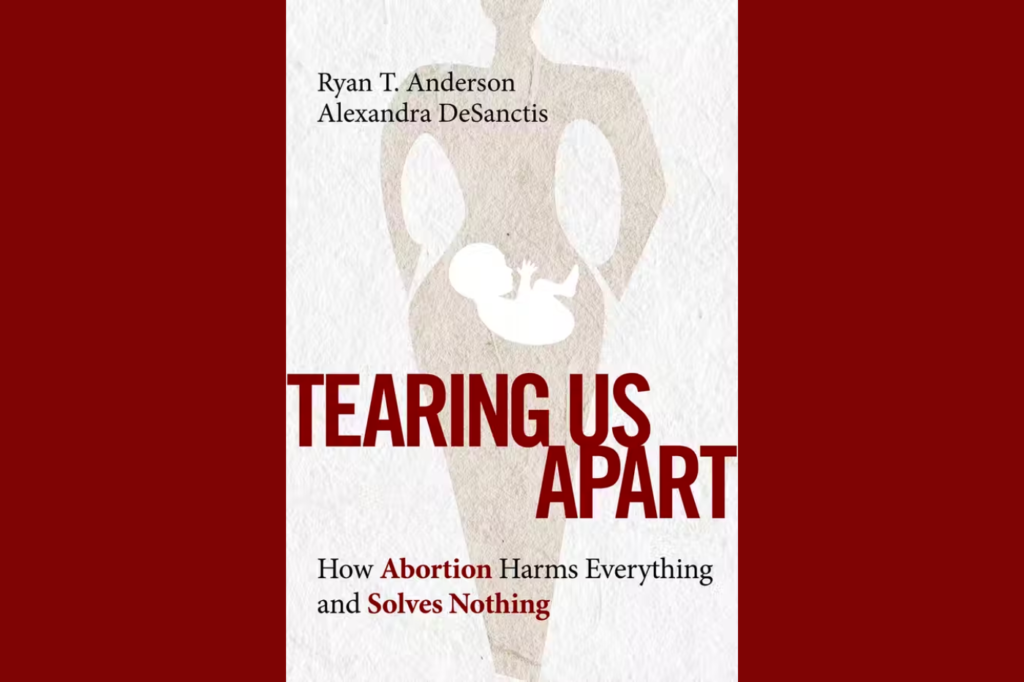Perhaps the post-Dobbs euphoria has died down a bit?
I still feel it, but I must admit that the positive feelings are starting to wear off and the stress about the heavy (nay, gargantuan) lift that the pro-life movement has before it is beginning to really sink in. I mean, anyone with any sense of what was possible after Dobbs already knew this was coming on an intellectual level. But the size of the lift that is involved in trying to win hearts and minds in states like New York, Illinois, and California, for example, is now hitting home for real.
When various media and others have asked me how I feel, I’ve analogized crossing this Supreme Court threshold to what it feels like when being cast in the school play, making the varsity team, or getting into college. The conditions for the possibility of ultimate success have been met, and that can be thrilling, but now the real work begins. And to work smart, not just hard, it helps to have guides who have thought a lot about how to succeed in this scenario, and who are plugged into the pro-life movement’s latest dynamics and expectations.
In our post-Dobbs scenario, if we want to avoid the criticism that the dog who caught the car faces, it would be difficult to find a pair of guides who are as wise and as plugged in as Ryan Anderson and Alexandra DeSanctis. Neither needs an introduction to Public Discourse readers, but let me say this: if one could somehow add together (1) their level of moral and legal education on abortion with (2) their ability to read signs of the times pertaining to abortion, well, the resulting sum is surely higher than the efforts any other two pro-lifers in the United States could produce.
Start your day with Public Discourse
Sign up and get our daily essays sent straight to your inbox.That makes their new book, Tearing Us Apart: How Abortion Harms Everything and Solves Nothing, precisely the book the pro-life movement needs at this very moment.
To those who might ask, “Yet another book on abortion? How many of those could we really need?” I answer: “We need one that can help us reach those who identify as pro-choice in states like New York, Illinois, and California.” I don’t have in mind the ideologically dedicated abortion activists. Most of them require something akin to extended spiritual accompaniment in order to be moved on this issue. The folks I have in mind are reflexively pro-choice, but, like so many others, simply haven’t thought through the topic very much at all. These are the folks we need to reach if we are to win the future. Tearing Us Apart gives us a much-needed game-plan.
In our post-Dobbs scenario, if we want to avoid the criticism that the dog who caught the car faces, it would be difficult to find a pair of guides who are as wise and as plugged in as Ryan Anderson and Alexandra DeSanctis.
The Right Post-Dobbs Book
But, again, do we really need another abortion book for doing this? Aren’t there just so many other good ones out there? While this is an understandable concern, Tearing Us Apart understands and works within our current rhetorical and political impulses. Books like my own, written just a few years ago, now seem charmingly out of date in their assumptions.
For example, Anderson and DeSanctis know that, while our focus on prenatal justice for the child is the central plank of the pro-life movement, those we need to win over are less persuaded by this approach. While a tidy syllogism like “(1) all human beings deserve equal protection of the law, (2) prenatal children are human beings, (3) therefore prenatal children deserve equal protection of the law” may seem obvious and moving to us, the approach has its limitations in the public square.
With those limitations in mind, Tearing Us Apart focuses on harm. Indeed, each of the seven chapters is titled some version of “Abortion harms X.” This is a brilliant strategy, especially given that many of the groups we need to reach are deeply moved by references to harm in other contexts. The book takes on harm to the prenatal child, obviously, but also harm done to the rule of law, to the democratic process, media and popular culture, and even the concepts of equality and choice. Here, however, I want to make some brief remarks about how the book understands the harm abortion has done to medicine and then to women and the family.
Tracing Abortion’s Harms
I recently wrote a book arguing that secularized medicine is undermining fundamental human equality, and emphasized the role physicians play in leading the charge toward legal abortion. But Tearing Us Apart goes beyond this in uncovering a viciously reciprocal relationship in which abortion, in turn, fundamentally distorts and damages medicine. It has, for instance, turned an entire professional medical organization—the American College of Obstetricians and Gynecologists—into a political advocacy organization that is almost completely sold out to abortion extremism.
Also, the idea that abortion counts as “health care” (now taken as gospel in most secular medical settings) has totally distorted and even deconstructed the very idea that the practice of medicine has an objective referent at all. Obviously, tearing a disabled child limb from limb because she is unwanted due to her disability can in no way be reconciled with a coherent definition of health care. As a result, medical practice has increasingly become the name we give any transaction between an MD and someone who can pay him. Nearly gone is the idea of professional ends-based and normative medicine, having been replaced by something more akin to fast food where you, the customer, “have it your way.”
The chapter on how abortion harms women and families is as impressive as it is heartbreaking. Citing peer-reviewed study after peer-reviewed study, Tearing Us Apart demonstrates the physical, psychological, and even spiritual harms that abortion inflicts on women. Significantly, it is vulnerable women (and families) who are told that they require abortion to save themselves from their circumstances—but the massive increase in the feminization of poverty shows that abortion, if anything, has made the problem worse. Indeed, the logic of abortion goes directly against the idea that we may have unchosen obligations to care for needy women and families. In a very real sense, if a woman or family doesn’t avail themselves of abortion, the culture’s message is that they must now sleep in the bed they made.
Indeed, the logic of abortion goes directly against the idea that we may have unchosen obligations to care for needy women and families.
Missed Political Opportunities
But this does lead to my only significant criticism of the book: I really wish Tearing Us Apart had explicitly pushed the pro-life movement to take advantage of our new moment in the debate—and the massive realignment in our politics—to explore specific public policies at all levels of government. Doing so would have demonstrated that the pro-life movement will not hang women out to dry.
To be clear, the pro-life movement has done so much at the level of private charity, including the creation of a massive network of impressive crisis pregnancy centers—centers that outnumber abortion clinics three to one in the United States. Furthermore, DeSanctis specifically and regularly argues that “women deserve better than abortion.” And Anderson has been at the center of the EPPC’s laudable “Life and Family Initiative” geared toward offering “concrete support” to families. Despite all of this, however, the final recommendations articulated in their conclusion left me cold.
Though they call for abortion to be both “illegal” and “inconceivable,” and we are given many suggestions for how to get to the former goal, we aren’t given much to go on in terms of working toward structural changes that push toward the latter goal.
The book rightly calls for a radical rethinking of the sexual culture, made possible by abortion, which (among other things) undermines the family in demonstrable and disturbing ways. But nowhere to be found are formal suggestions that the pro-life movement should explore proposals like Mitt Romney’s massive child allowances. No argument is made for considering proposals like Marco Rubio’s to offer paid family leave. Ideas like Tim Scott’s bill to expand access to child care aren’t considered in the text.
Though they call for abortion to be both “illegal” and “inconceivable,” and we are given many suggestions for how to get to the former goal, we aren’t given much to go on in terms of working toward structural changes that push toward the latter goal.
Specific proposals to address abortion demand like those listed above are conspicuous by their absence in the book. Their omission is especially noticeable given the litany of specific proposals we see to address abortion supply, including an explicit suggestion that pro-lifers consider reviving our pursuit of a constitutional amendment making it clear that prenatal children are protected as persons under the Fourteenth Amendment.
Tearing Us Apart does try to head off this criticism by rightly noting that there is room for a range of opinions in addressing abortion demand, which seems to be the reason they don’t name specific proposals. But it is also true that there’s a range of possible strategies aimed at reducing abortion supply—yet this range of supply-reduction options doesn’t stop the authors from enumerating their preferred strategy. For example, there are so-called abortion “abolitionists” who disagree with an incrementalist approach that animates this book.
Still, the first steps that are now being taken in the pro-life movement to address abortion demand are moving us in the right direction. The absolutist, ideological libertarians have lost. Tearing Us Apart rightly calls for a “both-and” approach to addressing abortion supply and abortion demand that debates policies, not through the lens of a “small-government-vs-big-government” fight from a generation ago, but on the individual merits of the proposed policies themselves. That is, particular policies should be evaluated based on their demonstrated ability to reduce the kinds of harms this book so deftly articulates.
And with pro-life leaders like Anderson and DeSanctis at the helm, we have every reason to believe that the future of our movement will be guided, not by ideology, but by what will best serve the good of babies, women, and families. Here’s to the next step.













